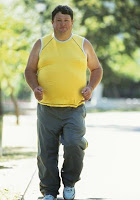 It has long been established that running is a great way to lose weight. In fact, many people engage in running because it is convenient, cheap and you don’t need any equipment to perform it. And if you get into running regularly enough, you will soon be rewarded with a fitter and trimmer shape. However, if you want to lose weight faster, then you should be running fast.
It has long been established that running is a great way to lose weight. In fact, many people engage in running because it is convenient, cheap and you don’t need any equipment to perform it. And if you get into running regularly enough, you will soon be rewarded with a fitter and trimmer shape. However, if you want to lose weight faster, then you should be running fast.As a runner, you will come to a point where you’ll feel physically and psychologically too familiar with the distance or mileage you cover. In short, running a certain distance may become boring for you. Reaching this point will make you realize that it isn’t just about adding an extra mile anymore. What you need is variety in your running routine and one way to introduce variety is by running fast.
If you have been running at a certain pace for a while now, you will find that your fat burning capacity has become dependent on your pace. The bad thing about sticking to a consistent pace is that it will make your body “immune” or “used to” that certain pace. As a result, your body can only burn a certain number of calories per session because that’s what your body has been accustomed to. Whereas, if you vary your pace your body will exert more energy based on the demands of the pace of your run.
Running coaches advise runners of running fast, to the point that they’re at the edge of your lactate threshold. Lactate threshold is the point when running becomes difficult. This is believed to be a pace you should ideally stay on if you want to maximize your fat burning capacity. Furthermore, research shows that running at your lactate threshold or just a little below it can help you expend more energy and optimize fat oxidation.
Another good thing about picking up your pace is you burn more after your workout. Researches point out that your metabolic rate after an intense workout is likely to pick up as well. Another published study also proved doing high-intensity workouts for shorter period of time have speedier metabolic rate than doing low-intensity workouts for long periods of time. For this reason, it is easy to see that running fast in a shorter time range can help you oxidize more fat after the workout than running a longer distance slowly.
However, you cannot just run fast right away if you want to burn more fats. You need to incorporate speed-training into your running workout once a week if you’re a beginner, or twice a week if you’re a professional. Furthermore, weight loss should not depend on running fast alone. You still need to choose your food wisely as this is an integral part of your weight loss efforts. You also need to be more consistent with your exercise and not drop just abruptly drop it. Instead, incorporate a variety of high-intensity workouts to furthermore optimize the benefits you can get from running.
